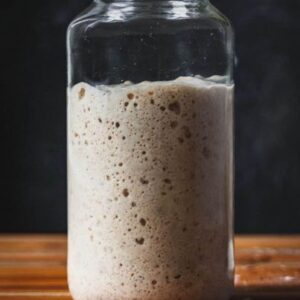The topic of sourdough starter care and feeding is one that is discussed often. The truth is, as with many things in life, there is more than one way to care for your starter. This post will detail for you how I care for and maintain my starter so that we can enjoy it’s beneficial goodness anytime we need to.

Why use a traditional sourdough starter? Don’t we have yeast now?
You may be wondering what the big deal is with sourdough right now. Currently there is a trend that has everyone on social media going crazy for sourdough. However, there are many of us that we using sourdough to feed our families and maintaining a starter regularly before social media was even a thing. In fact, I have my original sourdough starter from 2009 still going strong.
Sustainability/Resilience
The main reason you might choose to use a sourdough starter to cook with and raise your breads is because it fits in well with your sustainability goals. When you are obligated to purchase commercial yeast to raise your breads you are reliant on a system that may or may not always be available to you. Also, commercial yeasts do expire and/or die which is a waste of your resources.
Once you have a reliable starter established, it can last you for a lifetime. Sourdough starters were heritage resources that were often passed from generation to generation by families all throughout the settling of America. Starters were frequently passed along to new brides setting out on their journey westward to start their own homesteads.
Many of these strains are still in existence and use today. You often hear of “San Francisco Sourdough” or an “Oregon Trail Starter.” There are even “Alaskan Sourdough Starter” kits available. This is due to the hardiness, reliability and resilience of this wonderful food.

Digestibility
There is no denying the great digestive difficulties many seem to have with commercial breads today. Gluten intolerance is often blamed for this when it is really a matter of not properly preparing the wheat for consumption by the body. The hybridization of modern wheat strains has made the gluten content of commercial bread much higher.
To combat this, the fermentation process of sourdough bread is a wonderful ally. Fermentation allows the pre-digestion of many of the unsuitable aspects of bread to be avoided. Long fermentation of breads, waffle batters, bagels and doughs often allows those who thought they were gluten-intolerant to once again enjoy bread.

How can I find a sourdough starter to use?
Wild-caught yeasts.
Great news! You can actually capture and develop your own sourdough starter. By mixing a small amount of flour and water, loosely covering a jar with a breathable cotton or paper cloth, and setting it out on your counter, you can capture your own wild yeasts.
These friendly beasts exist in the air around us, on our skin, our foods, etc. Wild-caught yeasts are specific to the region you live in. That is why San Francisco sourdough has a specific salty tang that is unmistakable. Likewise, you will catch and develop your own locally region’s yeasts if you decide to grow a starter from scratch.
Online resources
For those of us who are impatient or don’t want to take a week to catch our own starter yeasts, there is the internet. Your first and best option would be to ask a friend who makes sourdough for a bit of her starter. The next best place would be online marketplaces and local homestead swaps. Lastly, you could also purchase one from Azure Standard, Cultures for Life, or even Etsy.
Just as when you start your own from local yeasts, the starter you purchase will have strains and characteristics of the region it is from. Once you bring it home and begin to use it, your sourdough starter will also morph into a new version with some of the yeasts that it originated with and those that it takes in from your environment.
How to care for my sourdough starter.
Caring for a sourdough starter is A LOT like caring for a new pet. If you will be using and refreshing it daily, then keep it out on your counter. If you only plan to use it a couple times per week or less frequently, then keep it in the refrigerator. You can even take a pause with sourdough by dehydrating and/or freezing a bit of it.
Hardy sourdough starters are REALLY HARD to kill. You may be able to revive one that is weeks or months old from the refrigerator by giving it a few days of good care and regular feedings. Do not be intimidated by sourdough. If it made the trip out west in a wagon-train, it can certainly survive on your homestead!

Feeding
There are literally dozens of ways to feed your sourdough starter and all of them work. There are variations based on hydration levels and whether or not you weigh or measure by volume. Again, all of them can be successful for you. If you do not like my method I am sure there is one out there that will work for your home and lifestyle.
Typically we do a once weekly large batch of baked goods that I use my starter for and then I also use my starter once or twice during the week for some overnight pancakes or waffles and then another time during the week for pizza dough or tortillas.
For the recipes that ferment overnight I am using a fed starter, aka “discard.” There really is no discard or waste with sourdough as all of it can be used immediately or collected in a jar in the refrigerator for use when needed. For recipes that I will use and bake with that day I am using an active starter, one that is bubbly fresh and ready to raise my dough.

Sourdough Starter Instructions
Equipment
- 1 quart Mason jar
- 1 Wooden Spoon or Chopstick
- 1 Fabric or Paper Towel piece to cover top loosely
Ingredients
- 120 g Sourdough Starter
- 40 g Whole Wheat Flour
- 80 g Unbleached All-purpose Flour
- 120 g Filtered Water not tap water
Instructions
- In the morning add all ingredients to wide mouth jar. Stir together. This should be the consistency of pancake batter. Cover the jar lightly. Oxygen needs to enter the jar, not bugs. The next morning: use or discard all but 120g of the starter and feed again.
- Sourdough starter is established and ready to use when it bubbles and at least doubles in size 4-6 hours after feeding.
Video
Maintenance
In between uses I will feed my starter as in the recipe above. Then I allow it to rise until doubled in the jar. I am careful not to wait so long that it begins to deflate in the jar. That is too long. Just before or as it doubles, I place it in the refrigerator to hang out until I am ready to feed and use it again. This can be days later or up to a week.
If you wait longer than a week, don’t panic. You have not killed it. Your starter will just be a little sluggish and may need an extra day or two of feeding before it is back to reliably doubling in size every 4 to 6 hours on the counter.
FAQ’s When working with a sourdough starter.
What factors affect the starter that I am working with?
There are four main factors that can affect your starter’s development: season, climate, room temperature, and individual flour properties.
How can I take a break from my sourdough starter routine?
Short break – to take a pause of 2-7 days remove approximately 2T of starter from the jar and simply place in the refrigerator for storage. For example, you might wake up in morning, remove the amount needed for baking, and place the remainder in the refrigerator for up to a week. No additional feeding of flour or water is needed until then.
Longer break – to take a pause of 1 week to 1 decade or more, remove approximately 2T of starter and place in a clean jar with a well-fitting lid. At this time feed it 2 1/2T Flour and 3T water, stir and cover with lid. Place it in the refrigerator with the lid on.
The refrigerator will drastically slow down the activity of the sourdough microorganisms. In 2 weeks, remove it, place 2T in a fresh jar, and repeat the process. You can then write the date that you need to feed it again on the jar with a Sharpie or dry erase marker.
Alternatively, you can remove 2T of starter to dry on a sheet of parchment paper. Once it is dry, crumble it lightly and store in a small glass container in the freezer until ready to revive and use.
The comments are a great place to learn from each other about what does and does not work for us in our homestead kitchens. Join in the conversation and let’s learn from others in the sourdough community!